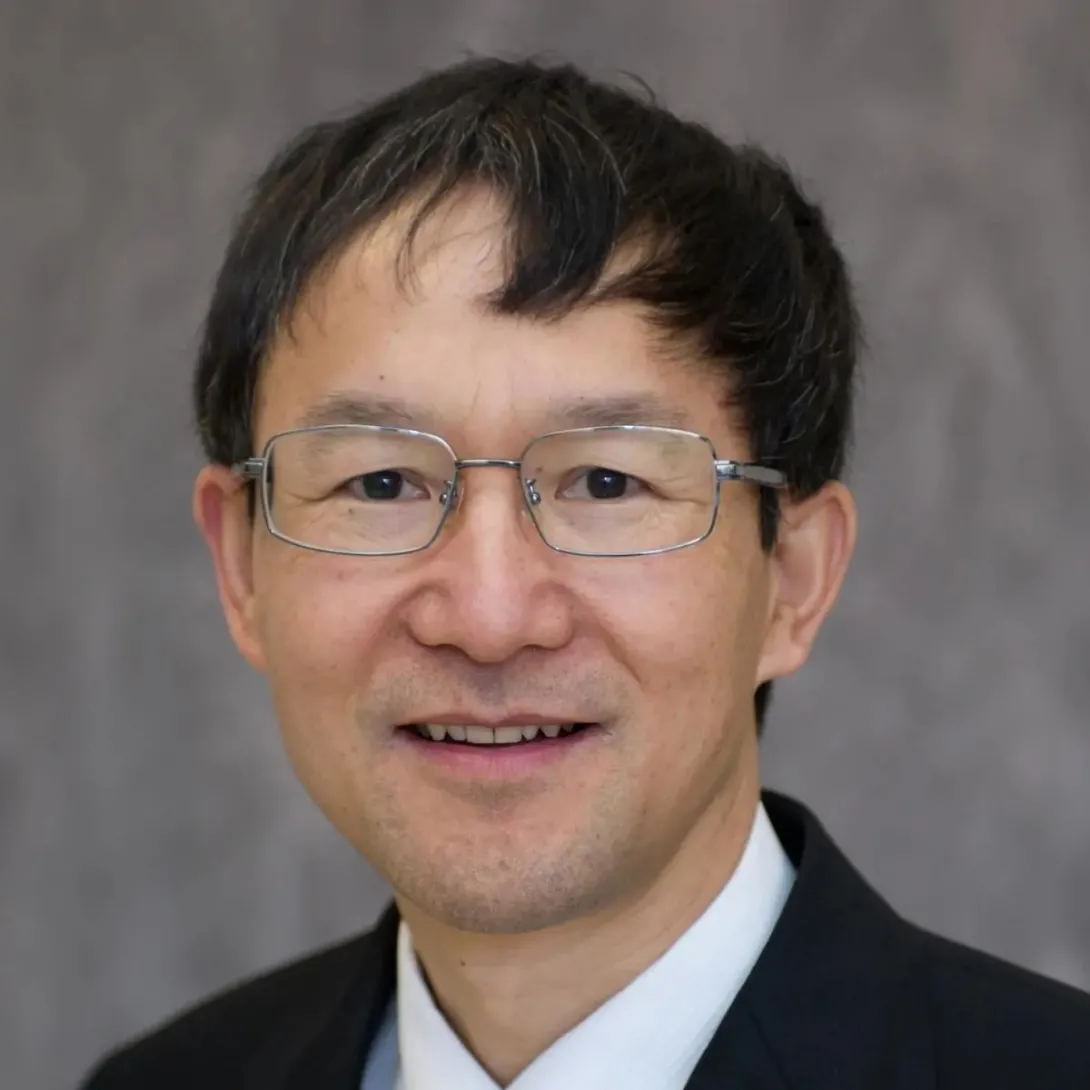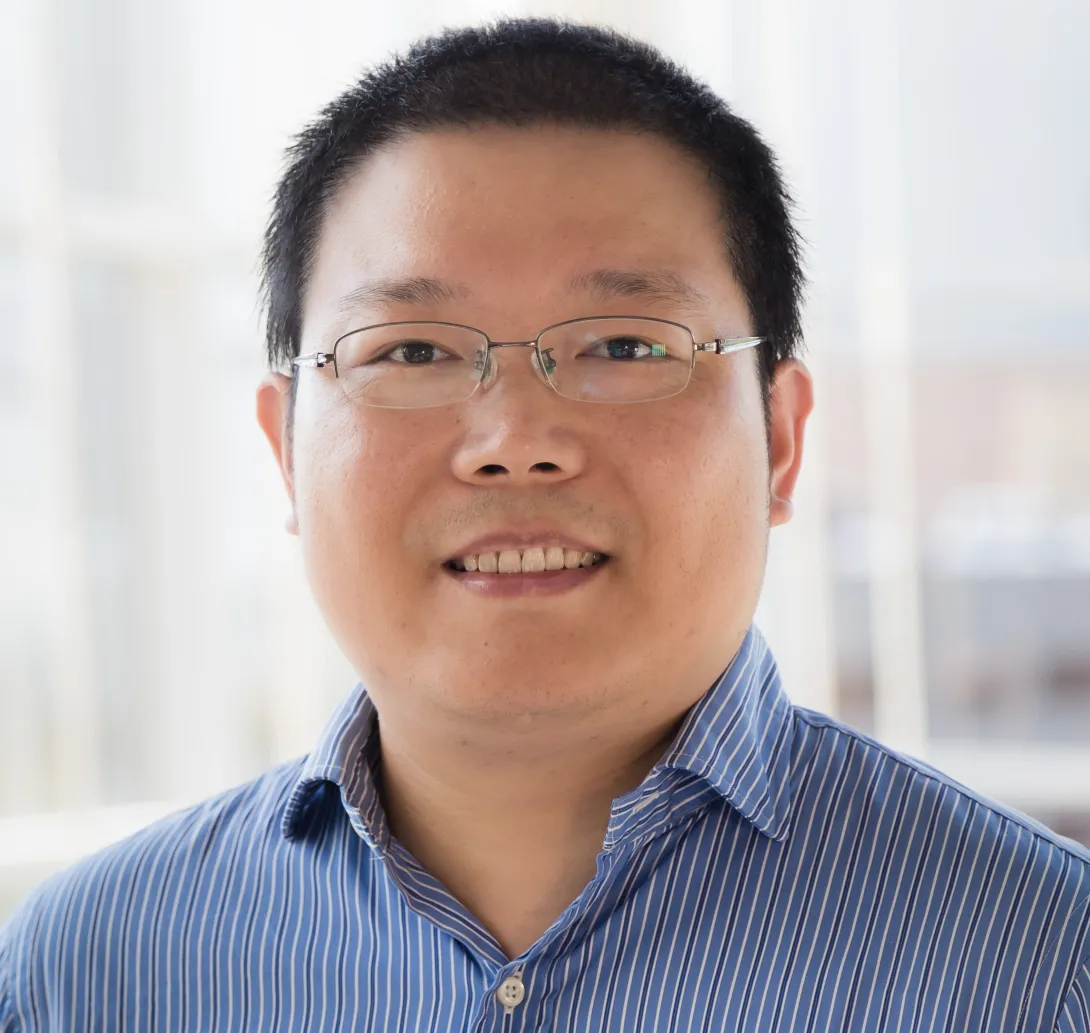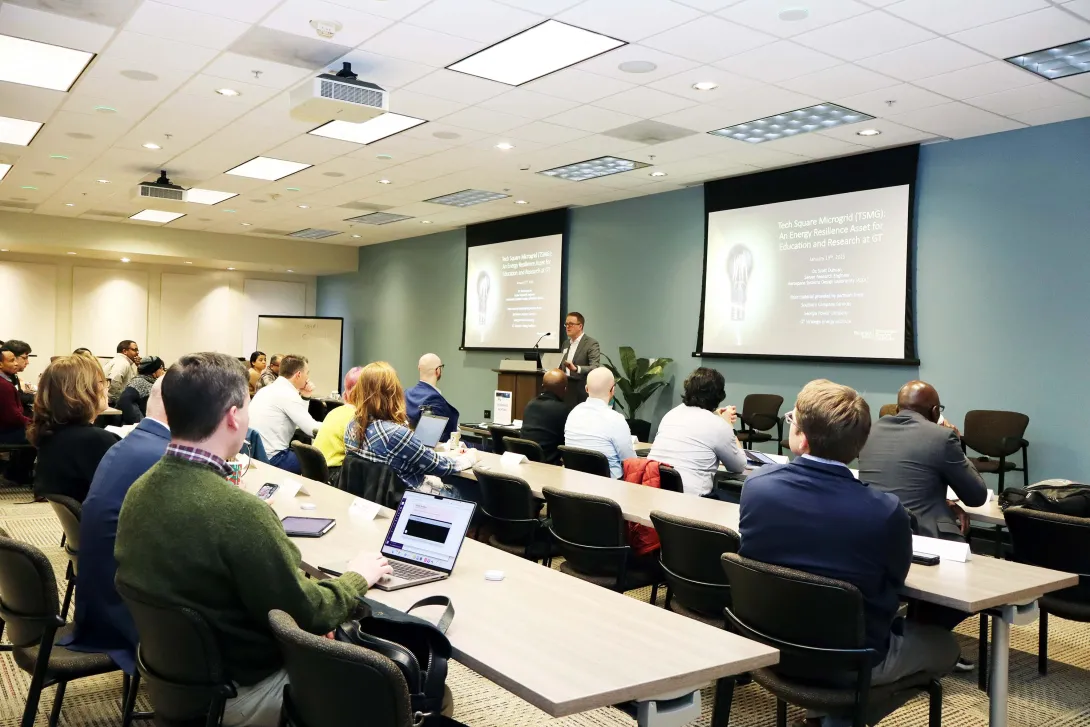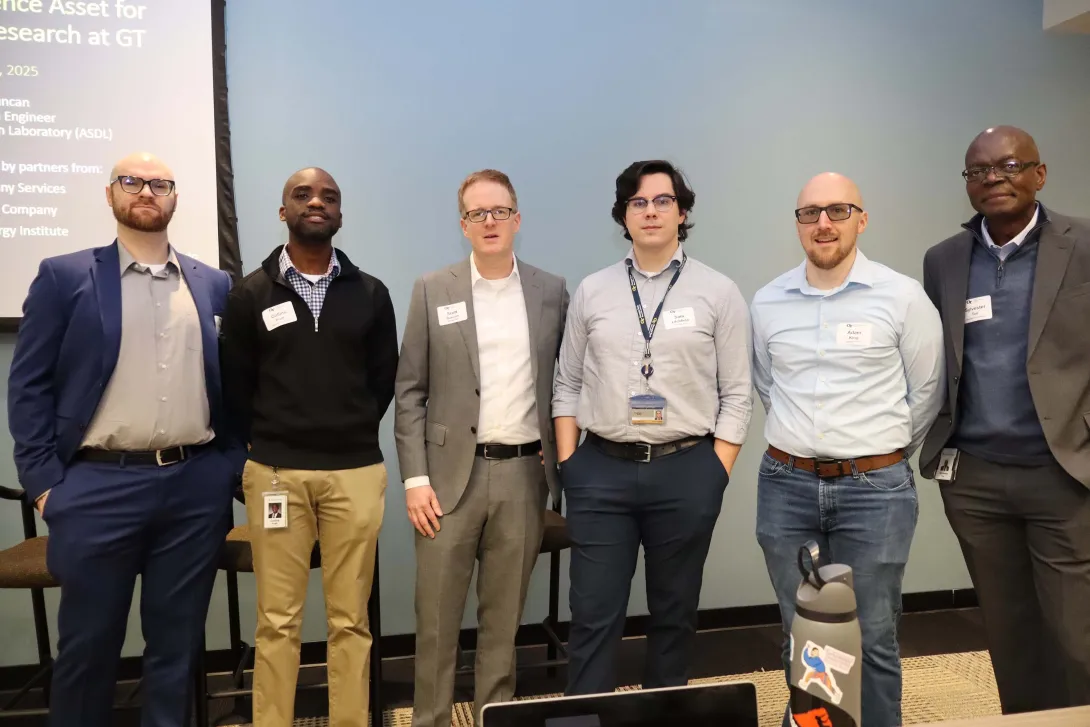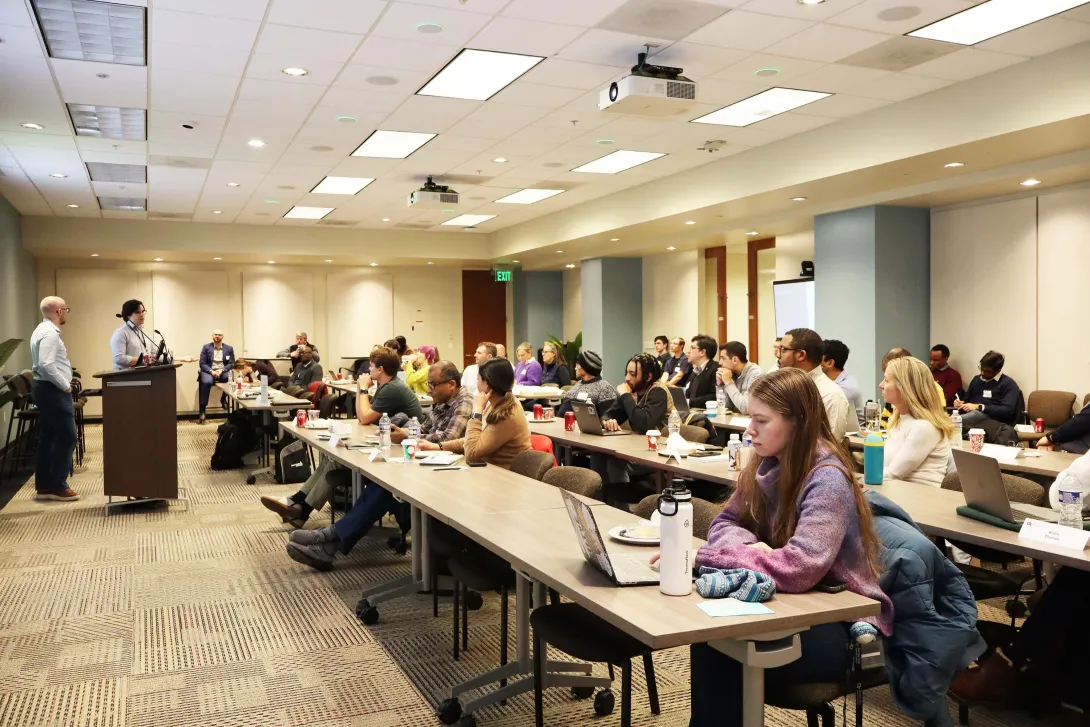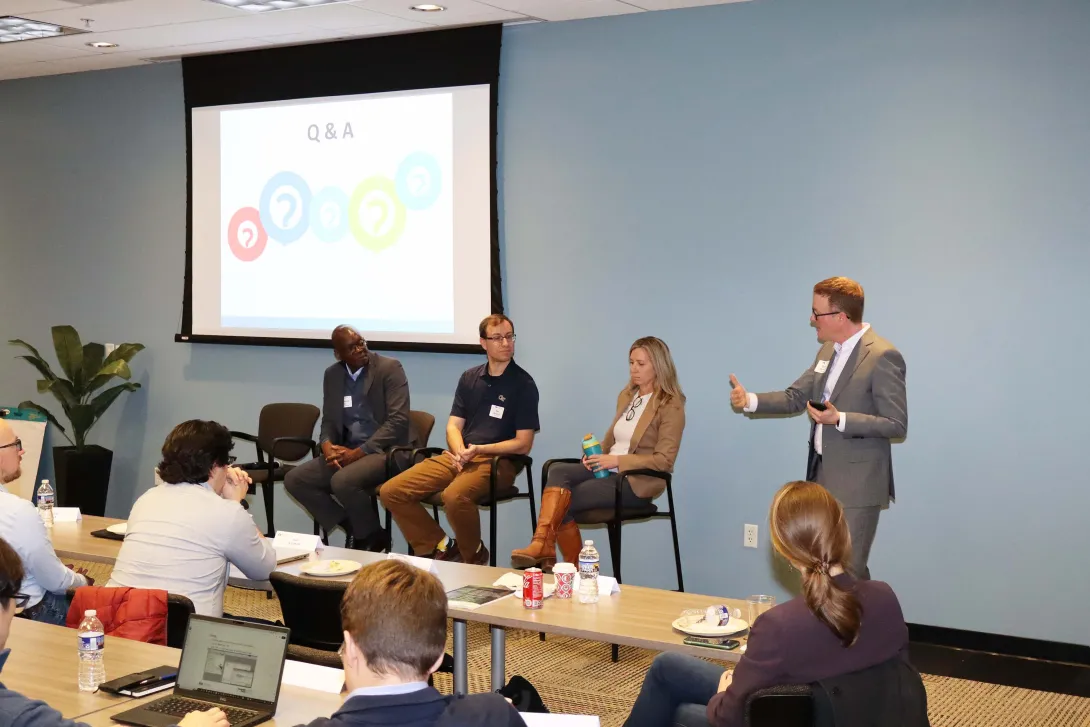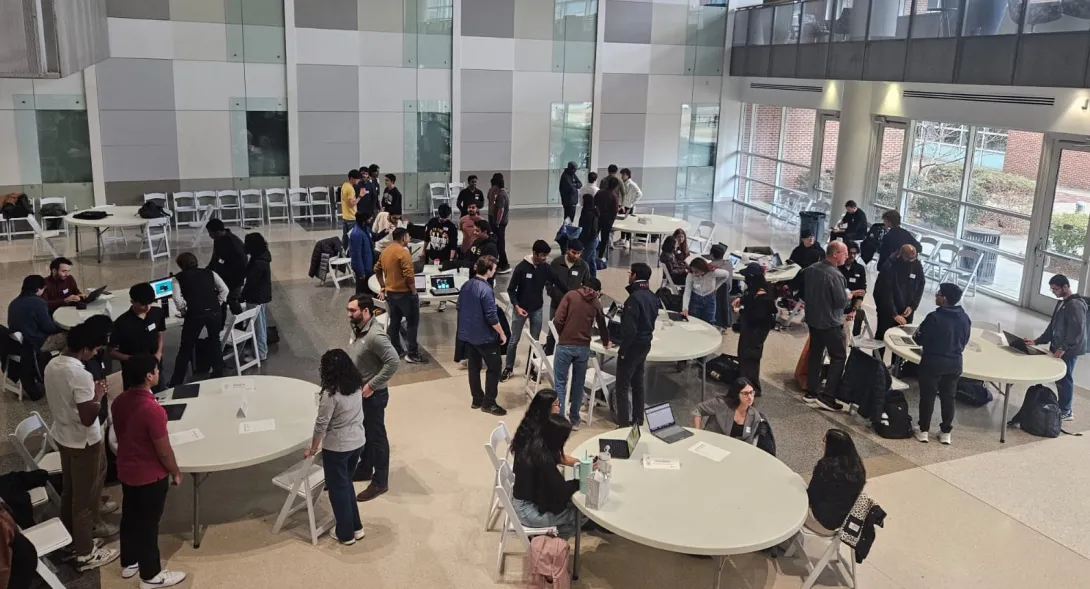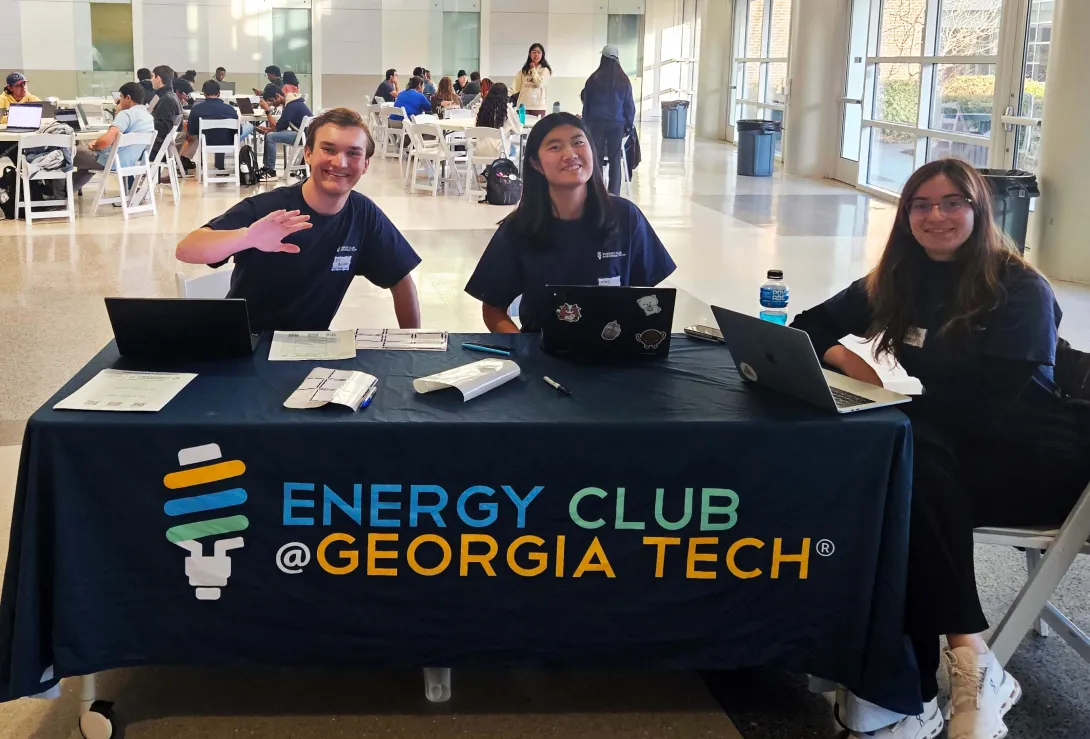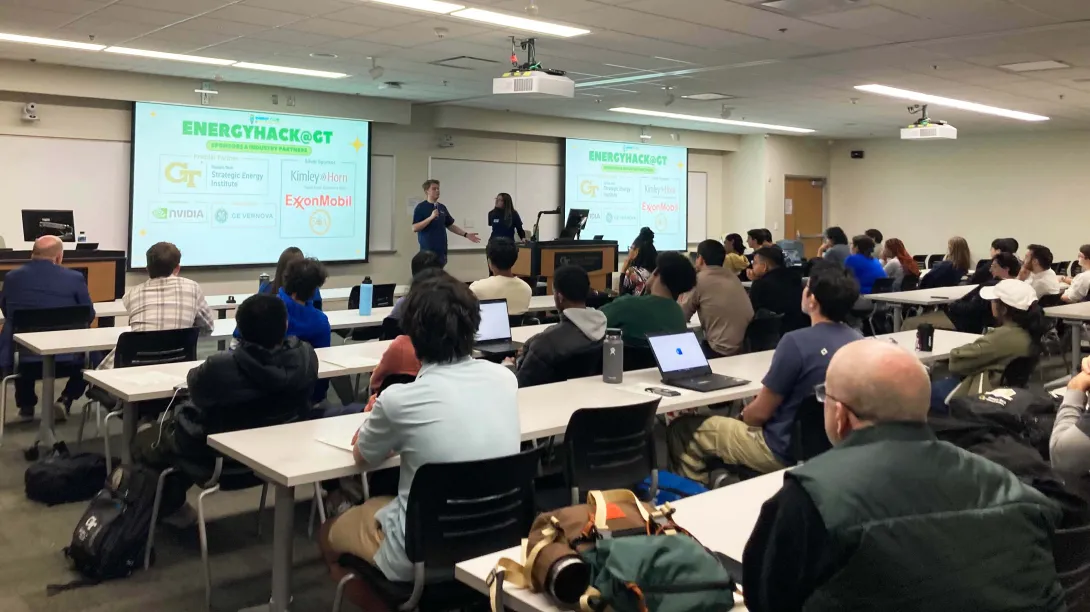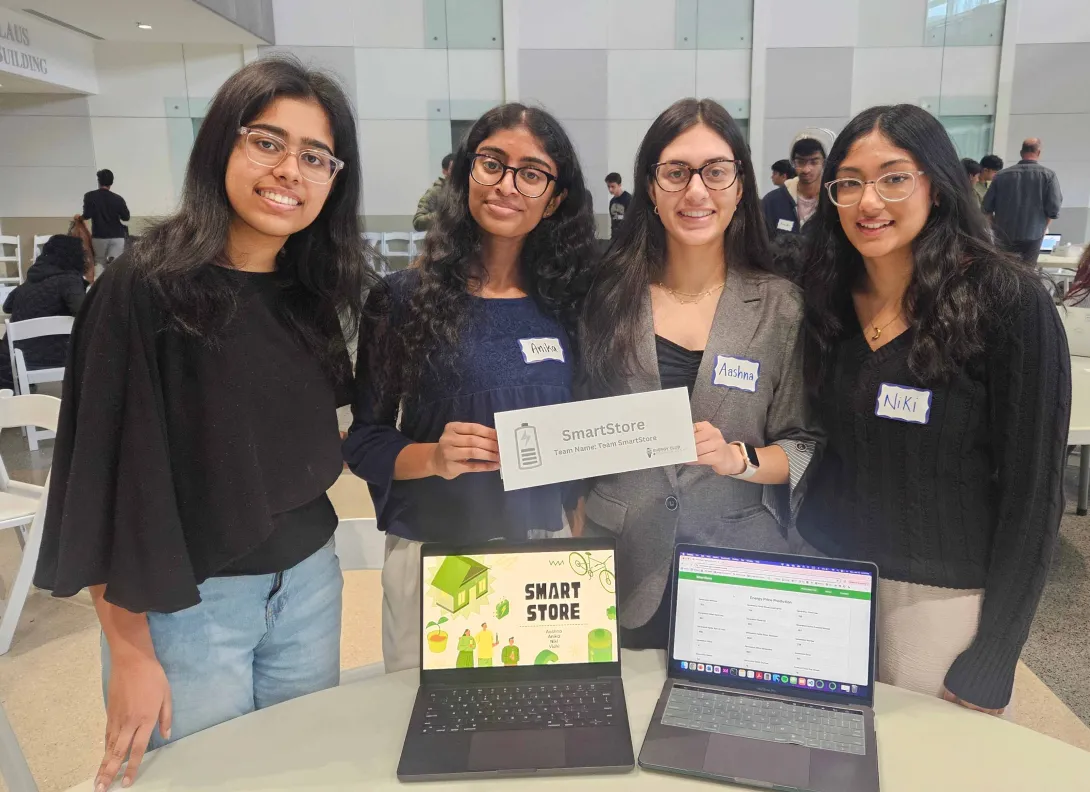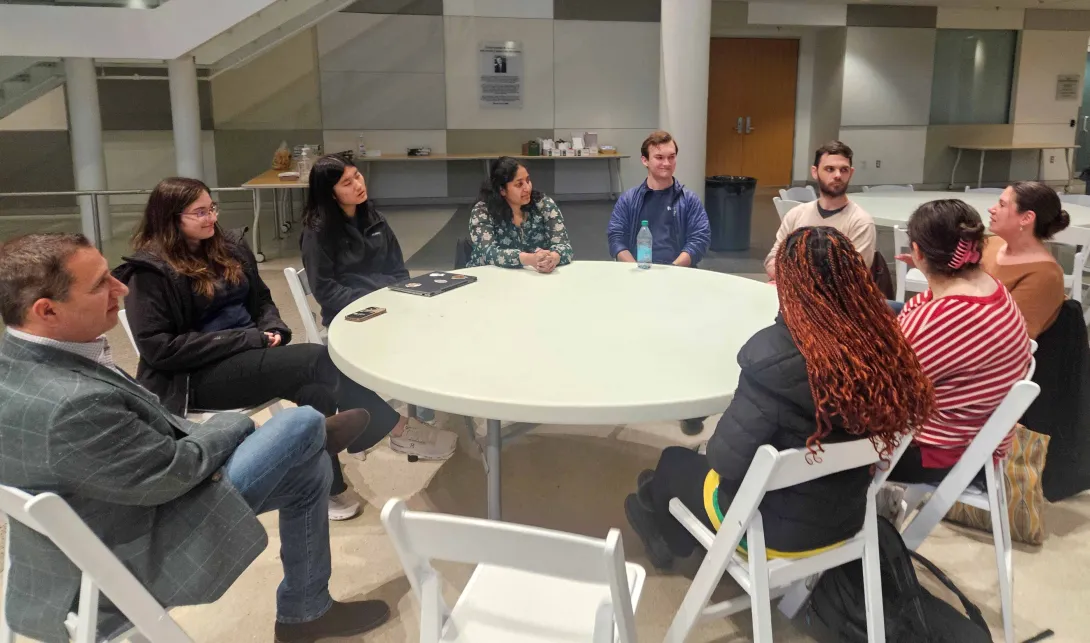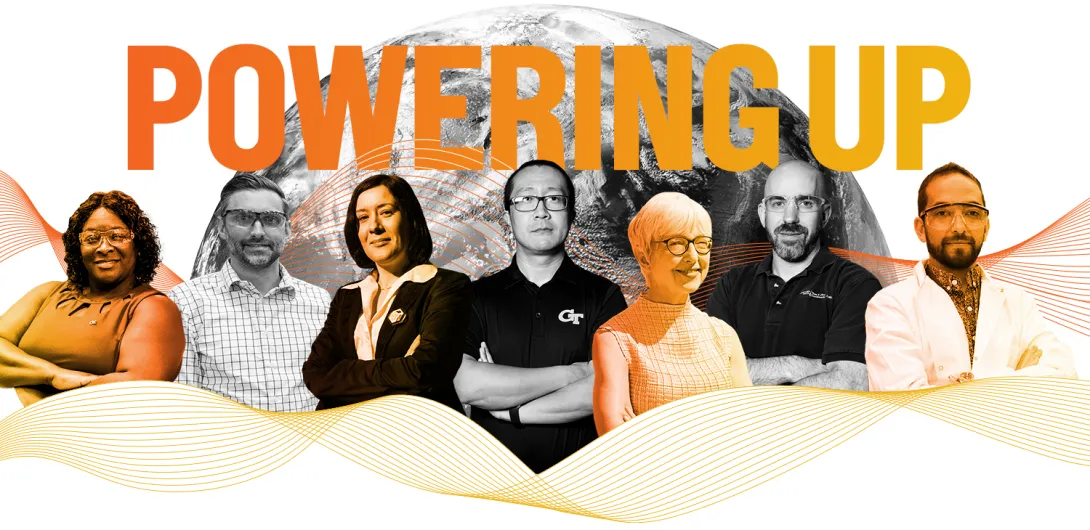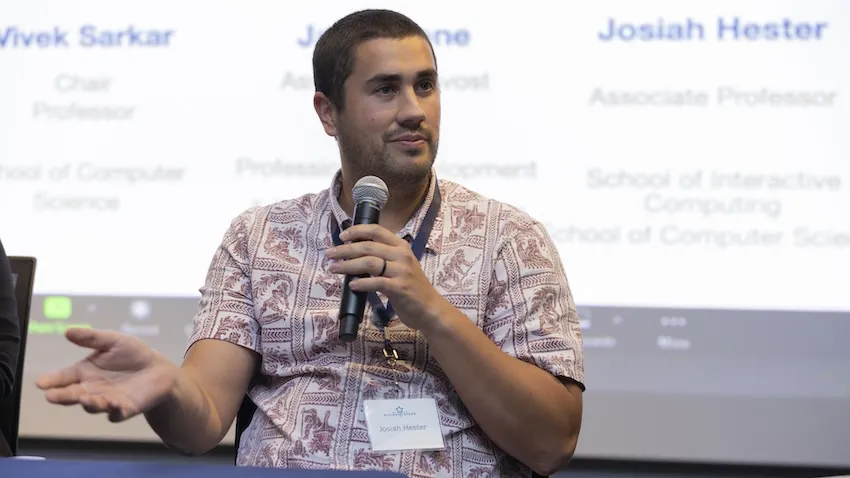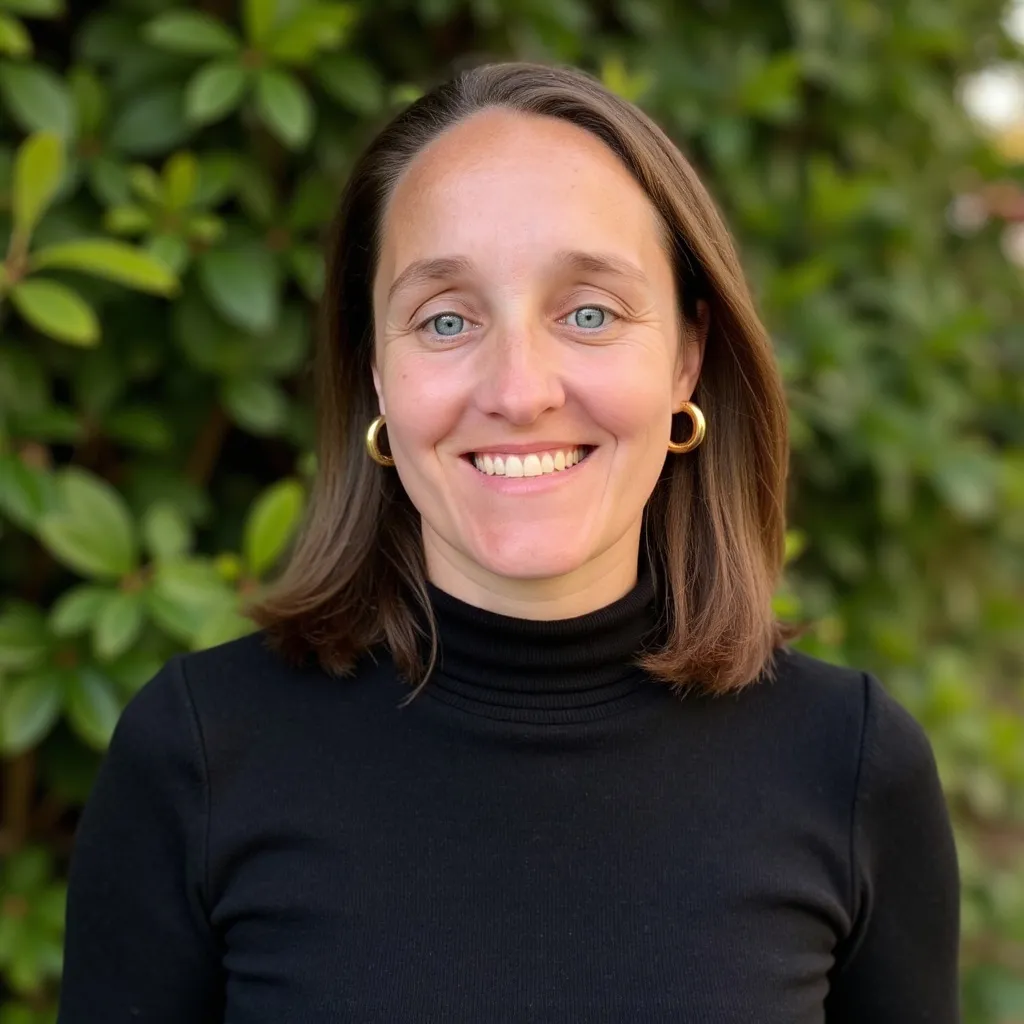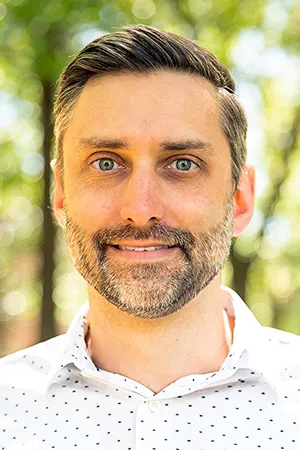Feb. 17, 2025
Someday, your drinking water could be completely free of toxic “forever chemicals.”
These chemicals, called PFAS (per- and polyfluoroalkyl substances), are found in common household items like makeup, nonstick cookware, dental floss, batteries, and food packaging. PFAS permeate the soil, water, food, and air, and they can remain in the environment for millennia. Once inside the human body, PFAS can persist for years, suppressing the immune system and increasing cancer risk.
Georgia Tech researchers, armed with a cutting-edge machine learning (ML) model, are spearheading a multi-university initiative. Their goal? To design a better membrane that efficiently removes PFAS from drinking water, a significant source of human exposure.
“More than 200 million Americans in all 50 states are affected by PFAS in drinking water, with 1,400 communities having levels above health experts’ safety thresholds,” noted the study’s principal investigator Yongsheng Chen, Bonnie W. and Charles W. Moorman IV Professor in Georgia Tech’s School of Civil and Environmental Engineering. Chen also directs the Nutrients, Energy, and Water Center for Agriculture Technology, or NEW Center. “Our research aims to provide a scalable, efficient, and sustainable solution for mitigating these toxic chemicals’ impact on human health and the environment.”
The resulting work, funded with over $10 million in multiyear grants from the U.S. Department of Agriculture (USDA), the National Science Foundation, and the Environmental Protection Agency (EPA), was recently published in Nature Communications.
Sewage Treatment Limitations
Conventional water treatment processes are ineffective at removing PFAS. Too often, traditional cleansing methods, such as using chlorine to kill pathogens in water, create harmful byproducts.
“Solving one problem creates another problem,” said Chen.
He has already used ML and artificial intelligence in precision agriculture to monitor nutrient levels in plants and insists that tackling PFAS removal similarly requires new approaches. Rather than treating an entire body of water, Chen’s team first separated PFAS from the water stream. Success depended on finding the right membrane material to isolate the chemicals in the water.
Chen relied on a team of 10 Ph.D. students and nine research scientists to perform the ML modeling. In addition to Georgia Tech, two other schools contributed people and laboratory expertise. The University of Wisconsin-Madison (UWM) validated the model with molecular simulations, while Arizona State University (ASU) trained it using data from scientific literature and their lab.
“Applying machine learning to membrane separation represents an exciting frontier for environmental engineering,” said Tiezheng Tong, an associate professor of environmental engineering in ASU’s School of Sustainable Engineering and the Built Environment.
This is another step in tackling PFAS pollution, a widespread problem that has recently received significant public attention due to PFAS’ toxic nature and the recent EPA ruling on PFAS in drinking water, he said.
“By integrating with molecular simulation tools, we can better understand PFAS transport across nanofiltration and reverse osmosis membranes, pushing the boundary of fundamental science relating to membrane separation,” Tong said.
ML Accelerates Membrane-Material Discoveries
Using ML modeling significantly sped up the discovery process. For instance, one Ph.D. student in Chen’s lab used trial and error over two years to pinpoint one promising membrane. Machine learning modeling allowed the team to find eight membrane candidates 10 to 20 times faster, reducing discovery time from years to a few months.
“Our molecular dynamics simulations reveal that electrostatic interactions, size exclusion, and dehydration play critical roles in governing the transport of PFAS molecules across polyamide membranes,” Ying Li explained. Li is an associate professor of mechanical engineering at UWM. “These calculations indicate that electrostatic interactions dominate PFAS rejection, with charged functional groups significantly influencing transport behavior. The simulation results provide fundamental insights that align with ML predictions, highlighting the key molecular determinants of PFAS removal efficiency.”
Addressing PFAS Exposure in Agriculture
By addressing PFAS contamination, this research could also benefit the agriculture industry, which depends on fertilizer sourced from water treatment plants. Wastewater biosolids are processed into fertilizer, offering farmers and ranchers a cheaper alternative to chemical fertilizers. Unfortunately, PFAS-tainted fertilizers from sewage sludge have contaminated significant amounts of land and livestock. Industry groups estimate that almost 70 million acres of U.S. farmland could be contaminated by these forever chemicals.
By funding this research, the USDA hopes that an effective membrane will help the United States reclaim this crucial resource.
“Synthesizing a very smart membrane to get rid of PFAS also allows us to recover the fertilizer from municipal wastewater treatment plants,” Chen said. “Such a membrane could enable us to get rid of things we don’t want and keep the things we need, so we can keep the water for irrigation or other applications.”
Eliminating PFAS in fertilizers also could help address the mismatch of food and water demand in urban versus rural areas since 80% of the demand resides in cities. PFAS removal could directly support urban area resource recovery and food production.
“Our goal is achieving a circular economy where materials never become waste, and nature is regenerated,” Chen said.
What’s Next
The team will fine-tune the model and add more data to improve its training features. Chen will synthesize membranes in his lab to further test the model's PFAS removal predictions.
Today, scientists have found ways to remove long chains of PFAS, but the shorter chains of these chemicals persist, explained Chen.
“If we can better understand the mechanism, we’ll be able to design a good material membrane to get rid of all PFAS. That could be game-changing.”
— By Anne Wainscott-Sargent
Funding
This work is partially supported by the NSF (Award Nos. 2112533, 2427299, 2345543, Y.C.; 2448130, T.T.; and 2345542, Y.L.).
Y.C. acknowledges the financial support by the USDA (Award No.2018−68011-28371), NSF-USDA (Award No. 2020-67021-31526), and EPA (Award No. 840080010).
T.T. acknowledges the support of the USDA National Institute of Food and Agriculture (Hatch Project COL00799, accession 1022591).
Y.L. acknowledges the financial support by the National Alliance for Water Innovation (NAWI), funded by the US DOE, Office of Energy Efficiency and Renewable Energy (EERE), Advanced Manufacturing Office, under Funding Opportunity announcement Number DE-FOA-0001905, through a subcontract to the University of Wisconsin-Madison.
News Contact
Shelley Wunder-Smith | Director of Research Communications
shelley.wunder-smith@research.gatech.edu
Feb. 04, 2025
On Jan. 13, the Georgia Tech Strategic Energy Institute (SEI), Southern Company, and Georgia Power hosted a workshop aimed at imparting new information and sparking innovative ideas around the Tech Square Microgrid (TSMG) and the use of its data in education and research.
Launched in 2021 with a 1.4-megawatt capacity, the microgrid is located on Williams Street, just south of Fifth Street in Tech Square. It is a joint project between Georgia Power and Georgia Tech.
The workshop brought together experts and enthusiasts to discuss the current operations of the TSMG, an essential asset for the energy resilience of Georgia Tech’s High-Performance Computing Center located next to Coda, and to share Georgia Tech studies that use data from the microgrid.
The workshop started with an overview of the microgrid’s current status and capabilities as a resilience resource, provided by Collins Pratt, the TSMG managing engineer from Georgia Power. This was followed by a keynote on TSMG modeling and simulation presented by GTRI research engineer and SEI’s lead on cybersecurity of critical infrastructure initiative, Sam Litchfield, and Adam King, a GTRI research engineer and Ph.D. student. Their insights into the state of the art of microgrid modeling and its role in assessing dependencies between energy grid resources set the stage for the rest of the workshop discussions.
During the panel on “Microgrids and Living Labs,” panelists from academia, Georgia Tech’s Office of Sustainability, and Georgia Power shared their perspectives on microgrid infrastructure and its role in research and education. The discussion emphasized the importance of microgrids as living labs, their potential for wider deployment in distributed energy systems, and the need for skilled graduates in the electrical utility workforce.
To conclude the event, attendees toured the microgrid site across the street. The tour, led by Pratt, provided a firsthand look at the microgrid infrastructure and its operating capabilities.
Reflecting on the significance of the microgrid, SEI’s Interim Executive Director Christine Conwell said, "The data from the microgrid is a vital resource for researchers at Georgia Tech and our metro Atlanta partners. It not only showcases our work in energy resilience but also serves as a living laboratory for developing innovative energy solutions."
Georgia Tech Senior Research Engineer Scott Duncan, who leads the Microgrids initiative at SEI organized the workshop along with Southern Company Principal Research Engineer Andrew Ingram. "The details shared during the workshop have sparked numerous ideas, from an array of perspectives across Georgia Tech, on how we can further utilize the microgrid and the unique data coming from its operations,” said Duncan. “The insights gained today will undoubtedly seed future research and collaborations, pushing the boundaries of what we can achieve in energy resilience."
News Contact
Priya Devarajan || SEI Communications Program Manager
Jan. 30, 2025
The "solar rebound effect" is a phenomenon where households with residential solar photovoltaic (PV) systems end up consuming more electricity in response to greater solar energy generation. This outcome arises because the cost savings from generating their own electricity lead to increased usage. A recent study by Matthew E. Oliver from the Georgia Institute of Technology and his co-authors, Juan Moreno-Cruz from the University of Waterloo and Kenneth Gillingham from Yale University, delves into this effect, providing crucial insights for policymakers and researchers.
The study, titled "Microeconomics of the Solar Rebound under Net Metering," explores how different net metering policies influence the solar rebound effect. Net metering allows households to sell excess electricity generated by their solar panels back to the grid, often at the retail rate. This policy makes solar PV systems more financially attractive but also impacts household behavior.
The authors developed a theoretical framework to understand the solar rebound. They found that under classic net metering, the rebound is primarily an income effect. Households feel wealthier due to the savings on their electricity bills and thus consume more electricity. However, under net billing, where excess electricity is compensated at a lower rate, a substitution effect also comes into play. This means households might change their consumption patterns based on the relative costs of electricity from the grid versus their solar panels.
The study also incorporates behavioral economics concepts like moral licensing and warm glow effects. Moral licensing occurs when people justify increased consumption because they feel they are already doing something good, like generating green energy. Warm glow refers to the positive feelings from contributing to environmental sustainability, which can either increase or decrease consumption depending on the household's values.
One of the key takeaways from the study is the importance of the regulatory environment. Policymakers need to carefully design net metering policies to balance promoting solar adoption while accounting for the possibility that rebound effects may offset the desired outcomes of grid resilience and reduced greenhouse gas emissions. For instance, switching from net metering to net billing might reduce the rebound effect, leading to better environmental outcomes.
The welfare analysis conducted by the authors shows that the solar rebound's impact on social welfare depends on various factors, including the cleanliness of the electricity grid and the external costs of electricity production. In cleaner grids, the rebound might be less detrimental, while in grids reliant on fossil fuels, it could negate some of the environmental benefits of solar adoption.
This research underscores the complexity of energy policy and the need for nuanced approaches that consider both economic and behavioral factors. By understanding the solar rebound effect, stakeholders can make more informed decisions to promote sustainable energy use.
For more detailed insights, you can explore the full study by Matthew E. Oliver and his co-authors. Their work provides a robust foundation for future empirical research and policy development in the field of renewable energy.
This article was written with the assistance of Microsoft Copilot (Jan. 27, 2025) and edited by Georgia Tech EPIcenter's Gilbert X. Gonzalez and Matthew E. Oliver.
News Contact
News Contact: Priya Devarajan || SEI Communications Program Manager
Written by: Gilbert X. Gonzalez, EPIcenter, Matthew Oliver, EPIcenter Faculty Affiliate
Jan. 28, 2025
EnergyHack @GT, Georgia Tech’s inaugural student-run energy and sustainability hackathon, kicked off Jan. 17-19, 2025. Organized by the Energy Club at Georgia Tech, the mission of the hackathon was to unite passionate students to tackle critical challenges in the energy industry while fostering innovation and collaboration.
Over the course of 36 hours, participants collaborated in teams to brainstorm, design, and prototype projects that promote sustainable practices based on diverse problem statements, addressing this year’s tracks: energy storage, energy security, and decarbonization. These themes targeted urgent issues, from balancing renewable energy supply and demand to safeguarding infrastructure against cyber threats and reducing greenhouse gas emissions. The projects were evaluated by a panel of judges.
Along with showcasing keynote speeches and educational workshops, the event culminated with the top three teams winning cash prizes. With more than 100 registered participants, 17 project submissions, and leaders from some of the biggest energy and tech companies, EnergyHack @GT successfully fostered collaboration and showcased the potential of student-driven solutions for advancements in energy and sustainability.
“The inaugural student-led EnergyHack was a tremendous success, and I am incredibly proud of the committee members for turning this brilliant idea into an outstanding event,” Dan Molzahn, assistant professor in the School of Electrical and Computer Engineering and faculty advisor for the Energy Club, said. “Their dedication and hard work truly brought this vision to life, fostering innovation and collaboration within the vibrant Georgia Tech student community.”
The event kicked off with an engaging opening ceremony featuring inspiring keynote speeches that set the tone for the hackathon’s ambitious objectives. Jessica Roberts, assistant professor in the School of Interactive Computing, shared insights into models used to track coal pollution sources and their dispersion across the United States. Steve Hummel, senior vice president at Chart Industries, discussed how artificial intelligence (AI) is reshaping demand projections and driving diversification in generation portfolios. Following the presentations, participants joined a dynamic team mixer to form diverse, multidisciplinary teams and networked with professionals from Kimley-Horn in a dedicated session.
Throughout the hackathon, participants had access to expert-led workshops and mentorship. A session on "Machine Learning (ML) and AI for Materials Screening and Discovery" by Victor Fung, assistant professor in the School of Computational Science and Engineering, explored the role of AI in advancing sustainable materials. A meet and greet with keynote speakers allowed participants to engage in thought-provoking discussions on energy and sustainability issues.
The energy and creativity peaked during the Project Expo, where 17 innovative solutions were showcased. Representatives from NVIDIA, GE Vernova, and other industry leaders reviewed projects, offering insights and feedback.
The closing ceremony celebrated the participants’ achievements and the event highlights, featuring a keynote by Priya Donti, assistant professor at the Massachusetts Institute of Technology's Department of Electrical Engineering and Computer Science and Laboratory for Information and Decision Systems, and founder of Climate Change AI, on using AI to combat climate change and to build sustainability solutions.
EnergyHack @GT served as a platform for innovation and learning, showcasing the potential of student-led initiatives in shaping the future of energy and sustainability. Awards were presented to the top three projects that stood out for their creativity and impact:
- Best Overall Hack: Watts The Power, a project that predicts the energy and environmental impact of training ML models, earned the team a $250 cash prize.
- Second Place: EcoTokens, a Chrome extension designed to reduce token usage in AI tools to save energy, won a $150 prize.
- Third Place: Eco Charge, an electric vehicle charging optimizer designed to minimize CO₂ emissions, secured a $100 prize.
News Contact
News Contact: Priya Devarajan || SEI Communications Program Manager
Written By: Braden Queen, Tejaswi Manoj, May Ming
Acknowledgments/Contributions by: Victoria Pozzi, Max Zhang, Eli Acree, Radhika Sharma
Jan. 17, 2025
For 20 years, Georgia Tech’s Strategic Energy Institute (SEI) has brought together campus researchers who collectively develop better ways to meet the energy needs of today and tomorrow.
These days, that amounts to more than 1,000 people. Georgia Tech faculty are creating advanced communications and information systems, sensing and control approaches, and transmission and energy storage technologies that will make the nation’s power distribution systems more efficient and cost-effective. Their research also focuses on integrating renewable energy sources and electric vehicles.
“As the nation’s largest technologically focused university, Georgia Tech is playing an integral role in developing solutions that enable more equitable, lower cost, and cleaner generation, storage, distribution, and utilization of energy,” said Tim Lieuwen, Georgia Tech’s interim executive vice president for research. Lieuwen knows SEI better than anyone: he had been its executive director since 2012 until stepping in this summer as interim leader of Tech’s entire research enterprise.
“Georgia Tech researchers are not just helping to create cleaner, more efficient fuel options or mitigate the environmental impact of conventional energy supplies. They also are creating better performing, more economically viable energy options,” he said.
The work at SEI and across Georgia Tech has helped make the state of Georgia one of the nation’s leaders in clean energy, battery technology, and energy sustainability. It’s attracting numerous companies to invest in research and development in the state, including Hyundai, SK Battery America, and solar panel maker Qcells.
News Contact
Jason Maderer (maderer@gatech.edu)
Director of Communications, College of Engineering
Jan. 16, 2025
A researcher in Georgia Tech’s School of Interactive Computing has received the nation’s highest honor given to early career scientists and engineers.
Associate Professor Josiah Hester was one of 400 people awarded the Presidential Early Career Award for Scientists and Engineers (PECASE), the Biden Administration announced in a press release on Tuesday.
The PECASE winners’ research projects are funded by government organizations, including the National Science Foundation (NSF), the National Institutes of Health (NIH), the Centers for Disease Control and Prevention (CDC), and NASA. They will be invited to visit the White House later this year.
Hester joins Associate Professor Juan-Pablo Correa-Baena from the School of Materials Science and Engineering as the two Tech faculty who received the honor.
Hester said his nomination was based on the NSF Faculty Early Career Development Program (CAREER) award he received in 2022 as an assistant professor at Northwestern University. He said the NSF submits its nominations to the White House for the PECASE awards, but researchers are not informed until the list of winners is announced.
“For me, I always thought this was an unachievable, unassailable type of thing because of the reputation of the folks in computing who’ve won previously,” Hester said. “It was always a far-reaching goal. I was shocked. It’s something you would never in a million years think you would win.”
Hester is known for pioneering research in a new subfield of sustainable computing dedicated to creating battery-free devices powered by solar energy, kinetic energy, and radio waves. He co-led a team that developed the first battery-free handheld gaming device.
Last year, Hester co-authored an article published in the Association of Computing Machinery’s in-house journal, the Communications of the ACM, in which he coined the term “Internet of Battery-less Things.”
The Internet of Things is the network of physical computing devices capable of connecting to the internet and exchanging data. However, these devices eventually die. Landfills are overflowing with billions of them and their toxic power cells, harming our ecosystem.
In his CAREER award, Hester outlined projects that would work toward replacing the most used computing devices with sustainable, battery-free alternatives.
“I want everything to be an Internet of Batteryless Things — computational devices that could last forever,” Hester said. “I outlined a bunch of different ways that you could do that from the computer engineering side and a little bit from the human-computer interaction side. They all had a unifying theme of making computing more sustainable and climate-friendly.”
Hester is also a Sloan Research Fellow, an honor he received in 2022. In 2021, Popular Sciene named him to its Brilliant 10 list. He also received the Most Promising Engineer or Scientist Award from the American Indian Science Engineering Society, which recognizes significant contributions from the indigenous peoples of North America and the Pacific Islands in STEM disciplines.
President Bill Clinton established PECASE in 1996. The White House press release recognizes exceptional scientists and engineers who demonstrate leadership early in their careers and present innovative and far-reaching developments in science and technology.
News Contact
NATHAN DEEN
COMMUNICATIONS OFFICER
SCHOOL OF INTERACTIVE COMPUTING
Jan. 09, 2025
Associate Professor Marta Hatzell has been appointed interim deputy director of the Georgia Tech Strategic Energy Institute (SEI).
Hatzell currently leads the industrial decarbonization and clean catalysis initiative at SEI and holds joint appointments in the George W. Woodruff School of Mechanical Engineering and the School of Chemical and Biomolecular Engineering. Most recently, she led the Materials for Carbon-Neutral Fuel Production track at this year’s Energy Materials Day, which attracted over 400 participants from academia and industry.
“Marta has been an outstanding addition to SEI’s initiative lead program, where her contributions have already made a significant impact. I am excited to see her further engage with the Georgia Tech energy community in this role,” said Christine Conwell, SEI interim executive director.
Hatzell’s research group focuses on exploring sustainable catalysis and separations to enable clean energy, water, and food production. She serves as the site principal investigator and research thrust leader for CASFER, the National Science Foundation Engineering Research Center (NSF-ERC) with funding of $26 million for advancing sustainable fertilizer production. She is also a principal investigator in the Department of Energy’s $100 million National Alliance for Water Innovation project.
Hatzell is the recipient of the NSF Early CAREER Award for her work on distributed solar fertilizers and received the Gordon and Betty Moore Inventor fellowship to work on a low-cost, photocatalytic air-breathing system that converts air into liquid, ammonia-based fertilizer. She also received the 2020 Sloan Research Fellowship in Chemistry and the American Chemical Society’s (ACS) Sustainable Chemistry Lectureship Award in 2024. Hatzell serves as a senior editor of the ACS Energy Letters journal.
Before her role at Georgia Tech, she was a postdoctoral researcher in the Department of Materials Science and Engineering at the University of Illinois Urbana-Champaign. She holds a Ph.D. in mechanical engineering from Penn State University.
“I’m looking forward to working with the SEI staff and faculty to continue to grow Georgia Tech’s impact on the rapidly changing energy sector,” says Hatzell.
News Contact
Priya Devarajan || SEI Communications Program Manager
Dec. 19, 2024
Associate Professor Matthew McDowell has been selected as the next Associate Chair for Research in the George W. Woodruff School of Mechanical Engineering. He will step into the role on January 1, 2025.
The Associate Chair for Research is responsible for working with the Woodruff School’s faculty to develop a strategic research plan for future growth and investments in the School, as well as identifying new research opportunities, helping to foster strategic relationships with government, industry, and foundations, and synergizing research efforts with other units in the College of Engineering and across the Institute.
“I am thrilled to be chosen for this role, and I look forward to working with the faculty, students, researchers, and staff of the Woodruff School to enhance and support our world-class research program,” said McDowell.
McDowell joined Georgia Tech in the fall of 2015 as an assistant professor with a joint appointment in the Woodruff School and the School of Materials Science and Engineering (MSE). He was named Carter N. Paden, Jr. Distinguished Chair earlier this year and serves as co-director of the Georgia Tech Advanced Battery Center (GTABC). Through this center, McDowell and Professor Gleb Yushin (MSE) are building community at the Institute, enhancing research and educational relationships with industry partners, and creating a new battery manufacturing facility on Georgia Tech’s campus.
“I am excited to work with Matt in advancing the research priorities and goals of the Woodruff School,” said Devesh Ranjan, Eugene C. Gwaltney Jr. School Chair and professor. “Through his exceptional leadership of the Georgia Tech Advanced Battery Center, Matt has demonstrated a deep commitment to excellence in scholarship and to fostering partnerships that drive innovative, collaborative research across the Institute. I am confident in the positive transformation he will bring to our program in this new role.”
Read More on the ME Newspage
News Contact
Dec. 18, 2024
The unstoppable rise of artificial intelligence (AI) continues to demand a vast and growing amount of power resources. Power has become increasingly expensive and taxing on current AI infrastructure, while also contributing to climate change.
Georgia Tech School of Electrical and Computer Engineering (ECE) Ph.D. graduate and current Stanford University research fellow Fabia Farlin Athena has made it her goal to make AI computing more efficient, while addressing financial accessibility.
Forbes honored her efforts by naming her to its annual North American 30 Under 30 Energy and Green Tech list. She was included alongside tech entrepreneurs, scientists, and public servants, all working to power a more sustainable future.
“I would like to extend my heartfelt thanks to my advisors, Prof. Eric M. Vogel and Prof. H.-S. Philip Wong, for their unwavering support and guidance,” Athena said. “I would also like to thank my mentors and collaborators at Precourt Institute for Energy at Stanford, IBM Research, and TSMC Corporate Research. Finally, I would like to thank Georgia Tech ECE for providing the platform to learn and grow during my Ph.D,”
Athena’s research focuses on developing emerging memory and logic technologies using oxide semiconductors and low dimensional materials for energy-efficient AI. Her current research focuses on high bandwidth oxide semiconductor gaincell memories.
She is in the midst of a prestigious three-year Stanford Energy Postdoctoral Fellowship sponsored by Stanford’s Precourt Institute for Energy and Doerr School of Sustainability, where she is working with electrical engineering professor H.-S. Philip Wong and materials science and engineering professor Alberto Salleo.
The fellowship aims to identify, develop, and connect the next generation of energy leaders — from science and engineering to policy and economics — to translate theoretical climate change solutions into tangible realities.
Athena is one of 14 Georgia Tech alumni, students, and faculty members named to the list, spanning nine categories.
News Contact
Zachary Winiecki
Dec. 18, 2024
Johney Green Jr., M.S. ME 1993, Ph.D. ME 2000, has been chosen to serve as the new laboratory director for Savannah River National Laboratory (SRNL). A proud Yellow Jacket, Green received both his master’s and doctoral degrees in mechanical engineering from Georgia Tech and currently serves on the Strategic Energy Institute’s (SEI) External Advisory Board. He also served on the board of the George W. Woodruff School of Mechanical Engineering from 2017 to 2022.
“SRNL has truly found an exceptional leader in Johney. His vision and dedication are inspiring, and I am genuinely excited to see the remarkable contributions he will make in advancing SRNL,” said Christine Conwell, SEI interim executive director. “We look forward to his continued partnership with SEI and the positive impact he will bring to the energy community in 2025 and beyond.”
The Battelle Savannah River Alliance (SRNL’s parent organization) selected Green for this role, describing him as “a dynamic leader who brings deep, wide-ranging scientific expertise to this new position.”
With an annual operating budget of about $400 million, SRNL is a multiprogram national lab leading research and development for the Department of Energy’s (DOE) Offices of Environmental Management and Legacy Management and the National Nuclear Security Administration’s weapons and nonproliferation programs.
Green currently serves as associate laboratory director for mechanical and thermal engineering sciences at the National Renewable Energy Laboratory (NREL). In this position, he oversees a diverse portfolio of research programs including transportation, buildings, wind, water, geothermal, advanced manufacturing, concentrating solar power, and Arctic research. His leadership impacts a workforce of about 750 and involves managing a budget of more than $300 million.
At NREL, Green transformed the lab’s wind site into the innovative Flatirons Campus and transitioned the campus from a single-program wind research site to a multiprogram research campus that serves as the foundational experimental platform for the DOE’s Advanced Research on Integrated Energy Systems (ARIES) initiative.
"We are immensely proud to call Johney a Woodruff School alumnus. His achievements and service to Tech through advisory board engagement inspires us, and we are excited to see him step into this prestigious role at SRNL. We look forward to deepening our collaboration with him as he continues to make a powerful impact,” said Devesh Ranjan, Eugene C. Gwaltney, Jr. School Chair and professor in the Woodruff School.
Prior to his role at NREL, Green held several key leadership roles at Oak Ridge National Laboratory (ORNL). As director of the Energy and Transportation Science Division and group leader for fuels, engines, and emissions research, he managed a broad science and technology portfolio and user facilities that made significant science and engineering advances in building technologies; sustainable industrial and manufacturing processes; fuels, engines, emissions, and transportation analysis; and vehicle systems integration. While Green was the division director, ORNL developed the Additive Manufacturing Integrated Energy (AMIE) demonstration project, a model of innovative vehicle-to-grid integration technologies and next-generation manufacturing processes.
Early in his career, Green conducted combustion research to stabilize gasoline engine operation under extreme conditions. During the course of that research, he joined a team working with Ford Motor Co., seeking ways to simultaneously extend exhaust gas recirculation limits in diesel engines and reduce nitrogen oxide and particulate matter emissions. He continued this collaboration as a visiting scientist at Ford's Scientific Research Laboratory, conducting modeling and experimental research for advanced diesel engines designed for light-duty vehicles. On assignment to the DOE’s Vehicle Technologies Office, Green also served as technical coordinator for the 21st Century Truck Partnership. He also contributed to a dozen of ORNL's 150-plus top scientific discoveries.
Green was the recipient of a National GEM Consortium Master’s Fellowhip sponsored by Georgia Tech and ORNL, and he served as the National GEM Consortium chairperson from 2022-2024. He is a Fellow of the American Association for the Advancement of Science and an SAE International Fellow. He has received several awards during his career and holds two U.S. patents in combustion science.
News Contact
Priya Devarajan || SEI Communications Program Manager
Pagination
- Previous page
- 4 Page 4
- Next page
